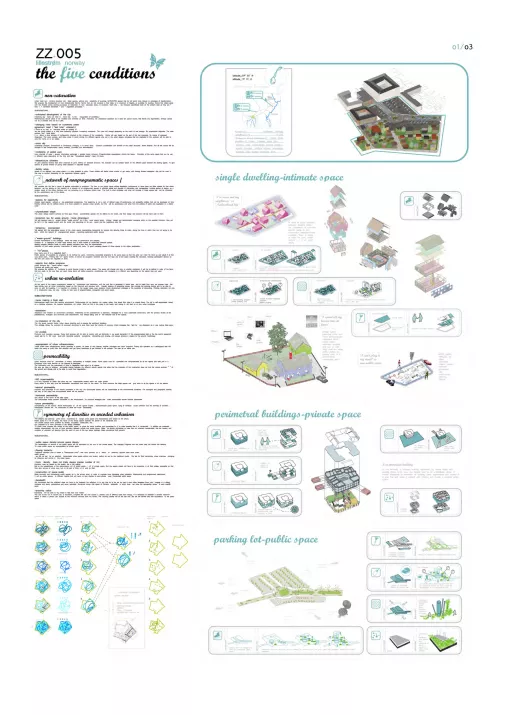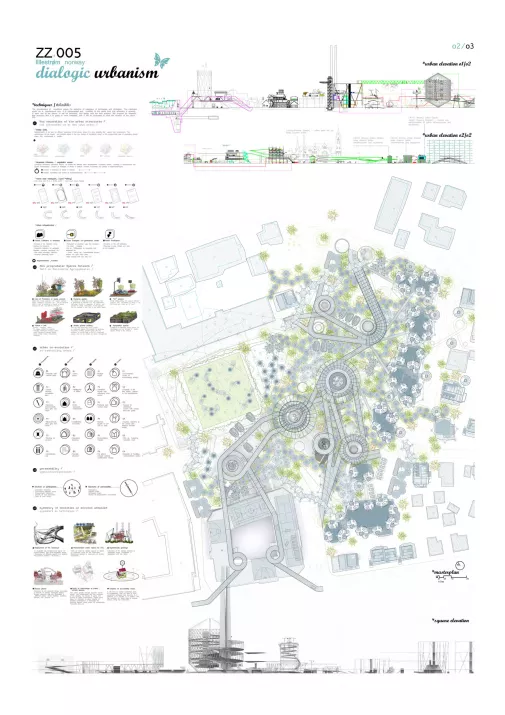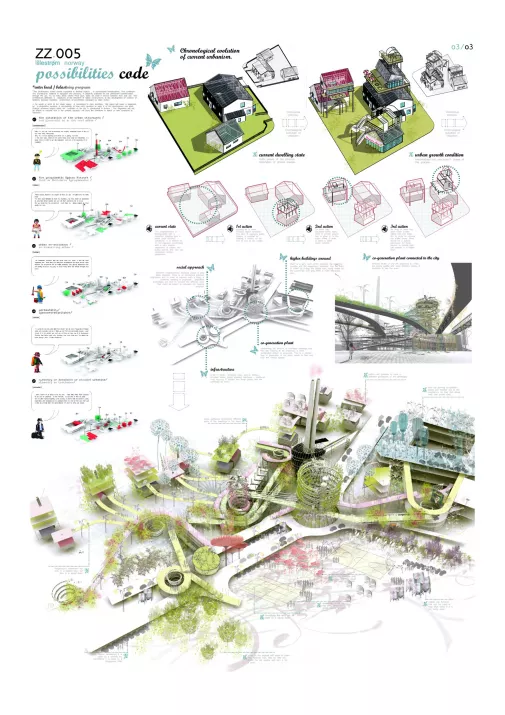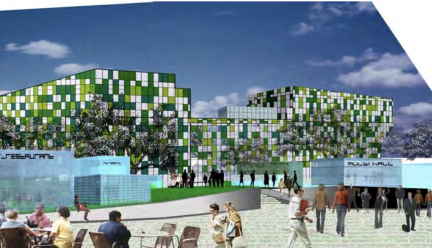Project:
The Five Conditions
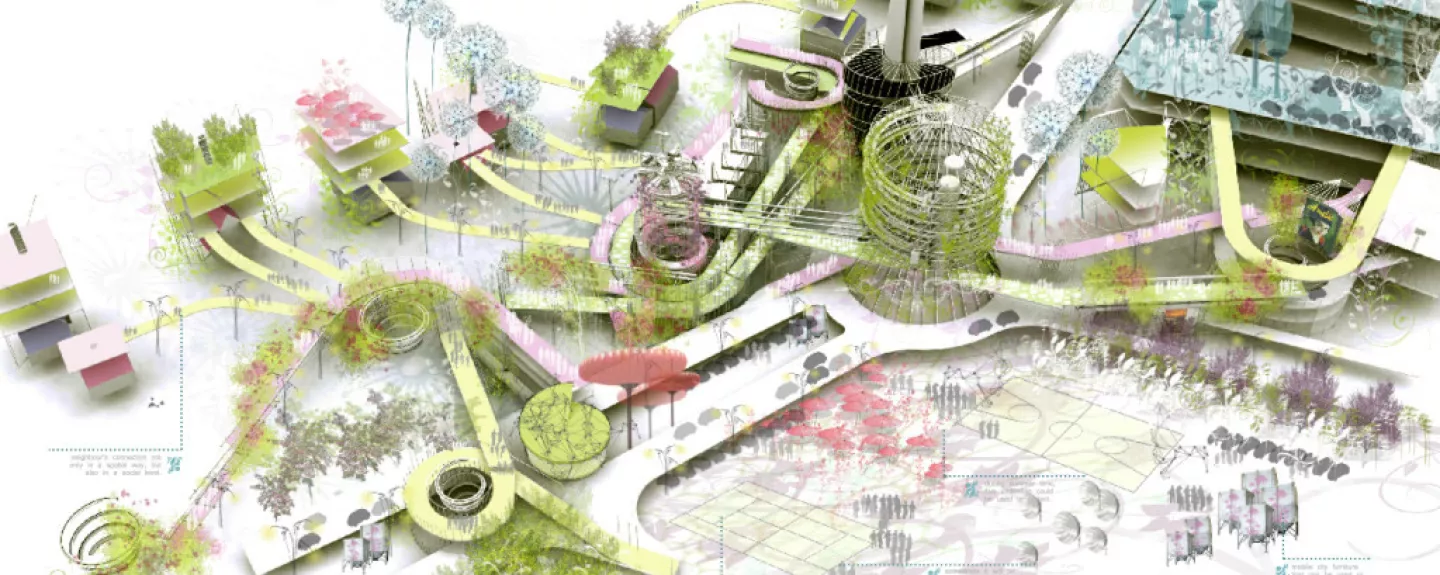
About
-
We propose the development of New non-saturated regulations: regulations that would not harbour a final state, nor a maximum height nor suitability for building. regulations that set in agreements with saturated areas, starting rehabilitation processes that are able to generate living spaces in continuous evolution. to do so we bring hitherto unknown tools in the current regulations code as “time”, “band width” and “agreement negotiations” (dialogical urbanism).
the five conditions:
01.
Non Saturation of the urban structures
Urban rules turn territory structure into dead spaces, without any possibility of evolving, SatUrateD spaces that do not admit more mixture or processes of transformation.
We propose the development of new nonsaturante Norms. Norms that do not conceive a final state, or a maximum of heights, or suitability for building. Norms that initiate pacts with the flooded zones starting processes of restoration in non- saturated areas, in evolution. that’s why , we introduce unpublished tools on the present rules as they are “ time ”, “ normative bandwidth ” and “ negotiation processes ”.SUBCONDItIONS_
01.1. unfinished development of the city
(there is no opening day or everyday something is inaugurated)
We believe in actions that allow themselves to be modified and to be given aid in time. therefore we believe that saturation is a state that cannot evolve, and that it blocks any kind of regeneration. entropy brought by a process and not by a plan01.2 changing rules based on prescriptive codes. agreement need (test-tube urbanism) (there is no regulation or everyone works on making it up)
It is about a slow configuration process that heads up to a complexity increase. regulations will change according to the testing of the real proposals. By means of propositive diagnosis. the code evolves, and takes part of the pacts among the different agents that operate in the urban space, the processes will be able to change the regulations or be included as such.01.3 city in crisis
principle of uncertainty. environment is being continously transformed. It is never definitive. Consolidation and constant renovation of the urban structures. It is never finished, and all the agents will be included in this transformation: users, builders, property development companies and public administration.01.4 multiplicity of superimposed uses
a greater diversity of uses that is equivalent to a greater information exchange, a greater social cohesion. to provoque a programmatic superposition that enriches the tissue. the skilled spaces will be encouraged. also the ones that are used in different ways depending on the time of the day and the day of the year. “24/7 spaces”.01.5 infrastructure urbanism
potencial support to be given, so that it allows urbanism growth without an absolut direction. evolution can be changeable depending on different agreements among the acting agents. Growth options instead of finished solutions in saturated spaces01.6 fertility orbitals
growing paths are not defined, but areas where is more posible that a growth can happen. this orbitals will define urban actions to prepare infrastructures and ground, with waiting strategies that will be used in different ways depending on the agreements among agents.02.
Un-programmatic spaces network
We consider the city as the addition os spaces asotiated to programs. Out-of-the-law spaces make us feel scared, the same as fences that dont allow free citizen behaviour spaces. We bet for the creation of a un-programmatic network in different scales and intervention stages and management. Spaces lacking design, where what it happens will be more related to reandomness of citizen behaviour and not following a determinated rule. truth is what it moves and what is going to be moving in these spaces will be influenced by the spontaneous use that will be given to those places. Open areas, that as along as they are to designed, everything is possible and whatever can be expected, possibility place, mandatorily protected from urban rules..SUBCONDItIONS_
02.1 chance spaces
the city needs spaces without a pre-established program. We dont start from defined action areas, but from probability orbitals, that may develop in time.fertility orbitals will be defined in places where it is more likeable to grow, but growth will be spontaneous and it will come up from agreement politics and negotiations in a neighbourhood scale.02.2 unpredictable shape
Urban design loses the vision of the final object: unpredictable spaces where design processes and evolution will be handed over to the users.02.3 waste land protection law (Lara almarcegui)
Laws that will protect some plots inside the city as if they were natural parks will be created. In this plots design will be limited and the managment action will be reduced to the minimum. Vegetal growth and social use will be at the expense of nature and routine character.02.4 temporary expropriation
We will make a pact with speculators, owners of urban space, temporarily expropiating their unoccupied plots allowing that, during the time they wont be built, they will be inside de un-programmatic spaces network, turning out into ephemeral public spaces.02.5 waste land buildings
Various interventions on buildings that are incide the action areas and analysis. Underused spaces catalogue to be created and a warehouse of spaces that might be built. the opportunity to have a variety of different public spaces in them, managed fom administration. to define waste land buildings. to do something in courtyards and roofs. to give the manager power of this spaces to the citizen.02.6 “or” spaces
(how many cars can fin on a basket ground?)
public spaces of the possibility to be created trough programs defined by users. Combination of compatible programs in the same places so that the actor can decide which one he want to enjoy at that certain point. parking lot “or” sports hall. Using this condition to contribute to ocupation and non-stop use of the space avoiding saturation. Devices will be created so that the own users will be able to manage this places.02.7 objects that define programs
(urban furniture as sport halls jails)
Furniture will qualify space. We propose adding a storage furniture with devices associated to public space. Space will acquire one or other character, it will be defined depending on the objects that are being used on it and on the way they are used. these objects will define different programs, conditioning and managements in the places they are used.03.
Urban re-evolution
as the result of the power consumption caused by construction and demolition, and the cost that is generated in tabula rasa and to begin from zero, we propose rules that take priority over all urban construction based on the historical and previous built. breeder systems of preexisting issues, that promote the evolving chance and to be able to carry on with its breeding. It is important to consider in the design cases open systems: future development strategies or the possibility of dismantling. thinking restoration not only in a construction way, but also inviting to take care of programmatical, managment and plural issues.SUBCONDItIONS_
03.1 Never making a fresh start
performances begin from tthe existing environment. performances do not destroy, nor create, rather, they breed from what it is already there. the city is self-regenerated, based on a talkative urbanism. No massive demolitions, nor rubble. What we find in the place is the basis, and raising it, will lead us to new urban prototypes
03.2 restoration
adaptation and reaction on environment conditions. potentiality of the preexistences is searched.. Strategies for a more sustainable construction, with the previous studies of the preexistences. energetic and economic cost improvement. and always taking care of the historical role of the spaces.03.3 re-implosion of the city
the city grows towards inside. urban tissue recycling and re-sewing the peripheral situations.
this strategy allows the evolution of saturated structures to give them back the chance of evolving. Urban strategies that fight for non-dispersion as a way making cities grow.03.4 re-versible
evolution and involution process. every built process will be able to evolve until we dismantle it. we would dismantle it if the programmatical load or the the actor’s agreement would ask for it. We must build with reversible systems considering dismantling and recyling, and always showing a respect for the ground morphology.03.5 appropiation of urban infraestructures
those under-used infrastructures should generate a growth, as paths of new tissues, heights, processes and urban programs. Finding this operation as a pedagogical task will teach the users to profit from this situation and get some assurance to get involved in the process. the user as an active role.04.
permeability
Urban structure must be permeable. It means, permeability in multiple scales. public space must be accessible and comprehensible for all the agents who take part in it
everybody must have devices on his disposal to participate.
the information and the guarantees of what is happening must arrive to all agents.But also we have to propose permeable spaces between the different natural agents that allow that the imposition of the construction does not limit the natural evolution “ ” of the ground and climate and to be able to avoid their degradation.
SUBCONDItIONS_
04.1 NO impermeability
It is very important to obtain that there are not impermeable centers within the urban growth.
every action in this way must be accessible, transparent and used by the users. to avoid exclusive the elitist spaces and give voice to all the agents in all the spaces.04.2 Vertical permeability
Inclusion and advantage of the natural processes in the city. No constructed system will be impermeable to the environmental conditions. the ecological and geographic diversity will stay of the place and environmental stress will be reduced.04.3 horizontal permeability
the citizen is the owner of his daily space
the inaccessible areas become vulnerable to the manipulation. to introduce strategies that make impermeable spaces become permeables04.4 cross permeability
transparency of the actions. active participation of all the agents implied . autoconstructedpublic space, trying to develope social cohesion and the diversity of activities. participation devices will be constructed to allow this cross- permeability
05.
Symmetry of densities
the present city-planning gives more importance to design some places and characterizes ones based on the others.public space is a lot of times, the result of the empty spaces between the private or the residential one.
the private spaces were qualified by density, occupation, construction, etc...Our proposal is to have symmetry in the design processes to make more complex the values of the public space, to grant the same qualities and guarantees to it, to make possible that it is constructed . In addition we presented another characteristic, the one of have simmetry between private and public space. Make its density simmetricar to raise from an urbanism nonsaturated, that the revision and evolution of urbanism will become from the point of view of the two space typology. Make simmetrical both growths
SUBCONDItIONS_
05.1 public SpaCe DeNSItY= private SpaCe DeNSItY
the densification of actions in the public space will be equivalent to the one of the private space. the changing programs and the mixed uses will foment this balance.
to make public space as representative as private space05.2 Flowing hierarchy
traditional urbanism tries to obtain a “hierarchized order”, with road, dowries, as a theory of hierarchy, spanish cities were under
traffic control.we did not bet for an absolutly hierarchizied urban space without any control, neither do we for the traditional model. We bet for fluid hierarchies, urban directives changing its influence and control in the urban space.
05.3 More density does not imply always greater number of m2.
evolution must be based on the quality, not in the quantiy. Not to the wastefulness of the space.space. m2 of public space = m2 of private space. But the square meters will have to be accessible, in all their scales, accessible so that they give service of some type, just to be part of them, or to walk by them
05.4 Construction of space-public
Make simmetry and characterize public spaces as in the private ones, in order to originate more interesting urban situations, infrastructural and programmatic deployment.
It will be public spaces in different heights that will serve to give dowries to semi-private uses. Constructed public space05.5 Bandwidth
We considered that the urbanism does not have to be dogmatic but dialógico, is to say that he is not tax but that it must follow strategies forum and I engage in a dialog, contracts and pacts, participative and never saturated. -
At first glance the five conditions has a freshness, a kind of original approach in its methodology that could eventually produce an intelligent design, but beside this idea the final result is somehow arbitrary in relation to the five conditions presented. the five conditions, has some interesting ideas for programming, but do not show the connection to the actual site and there is almost a contrast between the analyzes and the chosen design. It spreads the program and buildings out on the whole public space, were the public square is filled up with ramps and structures that are expensive to build, and unrealistic to implement on the site. It has playful illustrations and a social foundation for the method, good argumentation.
-
Team leader: Maria Carmona
Collaborators: Pilar Perez (Sp), Laura Flor (Sp), Lucia Martinez (Sp), Marta Catalan (Sp), Manuel Dominguez (Sp), Manuel Alvarez-Monteserin (Sp), Luis de Prada (Sp) Luis Belda (Sp), Elisa De los Reyes (Sp), Juan A. Chacon (Sp), Manuel Pascual (Sp)CONTACT
Conde Duque 44 28015 Madrid, Spain
+34 659 980 883
zirulon@gmail.com
